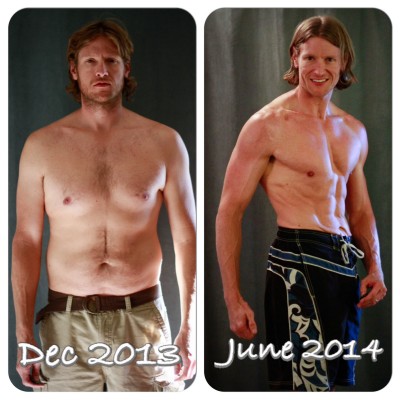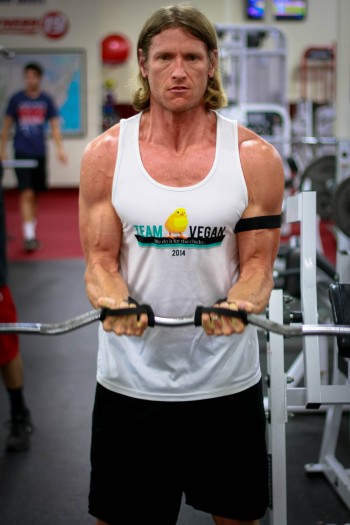Ryan Henn: A Vegan Success Story!
Sunday, September 7th, 2014If you’ve read my blog for long, you know that I mostly feature articles summarizing published research. But every now and then I like to have some fun that doesn’t involve comparing risk ratios and statistical significance.
I’ve known Ryan Henn since he organized the Vegans in Vegas conference in 2011. As serendipity would have it, he moved to the Sacramento area in 2012, right around the time I also moved back to the area. I actually never thought of Ryan as particularly out of shape but one day I ran into him and he was strikingly buff. I asked how he did it and thought his story was quite interesting, and he graciously agreed to write an article for my blog. I hope you will enjoy it!
How I Transformed my Body in Seven Steps
by Ryan Henn

For most of my life I’ve been fat. Not heavy, not rotund, stout, or any other euphemism you can toss out. No, I was fat. At age 18 I topped out at more than 300 pounds. Now a lot of that was due to chronic health issues, but my love of fatty meats, cheese, and refined food – and lots of it – was the major factor. By incorporating exercise and making small dietary changes, I was able to drop down to the 200-220 range by my early 20s. Even after adopting a plant based diet in 2004, I struggled with my weight, occasionally dropping down a few pounds only to watch them creep right back on.
In late 2013 I had my body fat measured using a dunk tank, also known as hydrostatic testing. I’d been working out pretty consistently through the years and figured I was in the 16 percent range. Turned out I was pretty far off as I was actually 20.1 percent; far from where I wanted to be. That meant I was carrying around about 40 pounds of fat, enough to fuel my body for more than a month and a half without eating a single bite of food. I knew it was time for a change. I renewed my commitment to getting fit and undertook a fitness challenge, vowing to lose the flab by the start of summer. So beginning in mid-December 2013 at 205 pounds, I began to buckle down with a cleaner diet and hit the weight room regularly. When summer arrived I had my body fat retested. I’d dropped down to 175 pounds and 7.1 percent body fat. That meant in six months time I’d lost more than 28 pounds of fat and also gained about four pounds of muscle.
I thought it might be helpful to others if I shared some of the lessons I learned during my weight loss journey. I’m no expert and I’m not pretending to be. In fact, I’m just getting started on my own fitness goals. There are many paths to getting fit and my only intention is to share the road I took in hopes that it will inspire you.
So here are the seven steps I used to transform my body:
#7 – Eat plants – lots of them
I’ve eaten a plant based (vegan) diet for nearly a decade. Despite this, I’ve always struggled with my weight. Let’s face it, just because it’s vegan doesn’t mean it’s good for you. Oreos are vegan. Enough said. Even though I actually ate pretty clean to begin with, and already limited my enjoyment of overly refined foods, I still couldn’t drop the pounds. I’ve always had a big appetite and get enjoyment from eating, which makes portion control difficult. However, compared with eating the standard American diet, I’ve found being vegan makes it much easier to stay within striking distance of my goal weight. Most natural plant foods tend to be lower in fat and calories while also containing a lot more fiber to fill you up. And of course, in addition to being very healthy, a vegan diet is also much better for the planet and our animal friends. I loaded up daily on green smoothies, peas, broccoli, zucchini, eggplant and squash.
#6 – Cut the cardio
I hate cardio. There I said it. Does that make me a weight loss heretic? Well, so be it. Turned out cardio was completely unnecessary in my success. I experimented with it at times to see if I could boost fat loss or stimulate my metabolism. And what did these efforts get me? Tired legs, poor sleep, and dramatically decreased recovery time. If you love running, keep doing it, but don’t think cardio is the only way to drop weight.
#5 – Eat those carbs!
Working out makes me hungry. That’s good since eating around your exercise session is ideal. Meals consumed pre-exercise help fuel your workout and meals afterwards help repair the damage inflicted. I typically worked out in the evening and always consumed 1/3rd or more of my calories post training. Post workout is also when I’d load up on carbs, although I also ate them throughout the day.
I found limiting my carbs killed my recovery and turned me into a general grump monster. So I aimed to get 40-50% of my daily calories from mostly healthy complex carb sources. The exception was post workout when I’d consume some sugary cereal and usually had a slice or two of whole multigrain bread with my dinner. The rest of the time I stuck to fruit, oatmeal, brown rice and the like. I aimed for a gram of protein per pound of bodyweight or roughly 25-30% of calories which left about 20-25% of calories from fat.
#4 – Stop cheating yourself out of results
There are a ton of questionable fitness articles on the web. Many of them proclaim that cheating on your diet with either a cheat meal or entire cheat day can boost your metabolism and help you drop fat faster. Of course they never have any hard science to back this up. I’m here to tell you it didn’t work for me. All it did was delay my progress and make it difficult to figure out if I was losing weight. Now, I’m not saying you should never “cheat” with a high calorie meal or day. I did and I think you should too. But not every three days and not even every week. At first I tried different schedules and carb cycling routines. However, what ultimately worked best for me was to listen to my body. In the beginning, about every two weeks and then about every week towards the end, I’d start getting hungry, like really really hungry. So I’d plan a day to eat at or above my maintenance calorie level and load up on carbs while trimming my fat intake back as far as possible. These excess carbs were used to fill up my depleted glycogen stores while not piling on a lot of excess fat. Chowing down on pizza and fries won’t give you this same effect and will just pack back on some padding (trust me, I learned this one the hard way).
#3 – Calorie counting sucks but you should do it anyway
All the tips and training in the world won’t do you a bit of good if you can’t control the basics – calories in vs. calories out. I struggled in the beginning and while I was losing weight, it was at a pretty slow rate. I was tracking calories consumed but had to make educated guesses about how many calories I was burning daily. Then I learned about the Bodymedia Fit (www.bodymedia.com) and it changed my whole life. Ok, not really. But it made losing weight so much simpler. You wear the Fit around your upper arm and it tracks energy expenditure to within a 5-10 percent margin of error. By showing you how many calories you’re burning, you can adjust your daily food intake accordingly to make sure you’re achieving your desired calorie deficit. If your deficit is too much, you will start to metabolize muscle for energy (see Calculating the Daily Calorie Deficit For Maximum Fat Loss). You can also see for yourself what does and doesn’t boost your metabolism and how many calories you are actually burning doing all that cardio. Turns out it’s probably a lot less than you think. I found it much easier to create a calorie deficit by reducing the amount of food I ate than by trying to pile cardio onto my weight lifting. I also knew that if I was hitting my daily deficit, daily fluctuations on the scale didn’t mean anything. Thus I was able to skip a lot of the second guessing and head games that can accompany dieting.
#2 – I don’t care about your politics so long as you’re a progressive in the weight room
Progressive overload is the concept that you should always be pushing yourself to be a bit better each workout. That means adding a bit of weight or an extra rep. Doing the same thing you did last week or last month just isn’t good enough. And if you’re not adding plates to the bar or pumping out an extra rep here and there, then it’s likely your recovery isn’t optimal. For me that meant I either wasn’t sleeping enough, wasn’t eating enough, or wasn’t resting enough.
For anyone who cares – or is even still reading at this point – I hit the weights 5-6 days a week using a three or four day body part split for about an hour each session. The body parts were split as: chest and triceps; back and biceps; shoulders, traps and abs; legs and calves. Roughly, I typically do 12-16 sets total per large muscle group broken into 3-4 sets per exercise (for legs, I count squats and dead lifts as both quads and hamstring exercises).
I alternate heavy and light workouts. For example, if I worked chest twice in one week I’d have a heavy day where I worked in the 2-8 rep range and a lighter day where I worked in the 8-15 rep range. This worked awesome and I was consistently able to add weight to all my lifts.
This sort of workout system might not be for everyone. The article Muscle and Muscle Fibers explains how to test your muscle fiber type to determine which workouts will be the best for stimulating your muscles.
#1 – Tank tops
Yep, tank tops are the key to everything. They’re light, breezy, sexy, and fun to wear. Plus everyone looks awesome in the gym if they wear a tank top – especially a Team Vegan tank top from Vegan Outreach!

In all seriousness, getting fit should be fun. Pick activities that you love to help ensure you stick to them. For me that meant lifting weights. But if you love running, cycling, hiking, or playing sports, then do that instead. While dropping weight wasn’t always easy and it required sacrifices at times, both from myself and my family, it was a ton of fun. There’s nothing as amazing as watching your body transform before your eyes.
I hope you’ve learned something from these tips and are inspired to embark on your own fitness quest. And remember, getting fit isn’t just about hitting a specific goal, it’s about the journey to get there. Oh, and be sure to pack a tank top or two just in case. You never know where your road to fitness might take you.
If you’d like more information or have any questions, always feel free to contact me at ryandhenn@gmail.com or on Facebook at www.facebook.com/ryan.henn.
Useful Links:
Body Media – for monitoring energy expenditure
New Grip – non-leather workout gloves
Vegan Weightlifting: What Does the Science Say?
Support JackNorrisRd.com
If you like my posts, please like my posts! Or share them. Thank you!
I greatly appreciate donations of any amount (click here).
Purchase anything through these links and JackNorrisRD gets a percentage:

